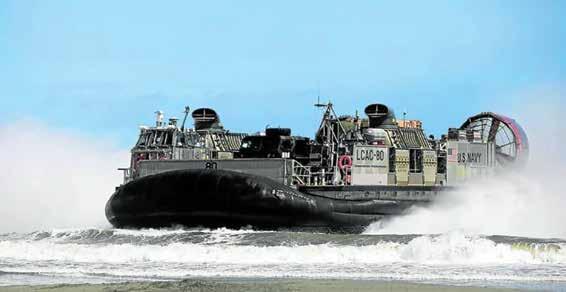
3 minute read
Marcos: PH needs ‘well-trained...
Despite the protests, Chinese vessels continued to sail inside the Philippines’ 200-mile exclusive economic zone (EEZ), confronting naval and coast guard ships.
Last month, a Chinese vessel beamed a military-grade laser at a Philippine Coast Guard ship.
Advertisement
“What is becoming more complicated and more difficult are the external threats that we are facing,” Marcos said.
“We have to have a sophisticated and well-trained military, and I can say that we
A ‘Balikatan’ rst: PH-US drills to sink...
The anticipated sinking exercise of an old fishing vessel will be held some 22 kilometers (12 nautical miles) off Zambales, or about 185 km (100 nautical miles) from Panatag Shoal which China seized from the Philippines in 2012, according to Balikatan spokesperson Col. Michael Logico.
He said it would be conducted by the two countries for the first time as the forthcoming drills focus on “maritime defense, coastal defense and maritime domain awareness.”
“We will be sinking a target vessel using a combination of artillery naval gunfire and aviation weapons… We will be firing HIMARS (High Mobility Artillery Rocket System), our artillery … a combination of Philippine Air Force and U.S. Air Force rockets and bombs, and our frigates,” Logico said of the sinking exercise. The U.S. Army will also hold its first Patriot missile air-defense exercise in the country as part of a coastal defense live-fire exercise, Logico added.
Last year, the United States deployed the Patriot, which stands for “Phased Array Tracking Radar to Intercept of Target,” as part of a mobilization exercise for the Balikatan drills. It was not used for live-fire training then.
Such a weapon system, touted as one of the world’s most advanced air defense systems, was provided by the United States to Ukraine to counter Russian missile and drone attacks. It can track and shoot down incoming missiles and aircraft with a minimum flight time of less than nine seconds and can travel up to 70km to a target.
“This Balikatan seems to be designed to test operational concepts to enhance strategic deterrence posture of the Armed Forces of the Philippines in the West Philippine Sea,”
Rommel Jude Ong, a former vice commander of the Philippine Navy, told the Inquirer
He said the large-scale deployment of American troops was a logistics exercise “to assess how it can rapidly deploy a large number of troops and equipment in theater.”
The sinking exercise would likewise test the Philippine Navy’s sea denial strategy, he said.
“It is premised on the idea that a land-based anti-ship missile can defend the country’s waters from any adversary’s naval shipping, even from a distance,” he pointed out.
Prelude to Balikatan
The use of the Patriot, meanwhile, would allow the AFP to understand “the need for an anti-air defense system which can protect our land and critical infrastructures from conventional ballistic threats,” Ong said.
When asked if the upcoming joint exercise could stir up China, Logico said: “We have the absolute, inalienable right to defend our territory. We are here to show that we are combat- ready.”
The defense of the Philippine archipelago from potential foreign aggressors is also the focus of the ongoing joint drills between the armies of the Philippines and the United States.
About 3,000 soldiers from the Philippine Army and the US Army are taking part in the annual “Salaknib” (shield in Ilocano) Exercise, which was first held in 2014,
The Army, the Philippine military’s largest service branch, is shifting its focus to territorial defense from insurgency amid China’s increasing assertiveness in the South China Sea.
“We will now be training on scenarios that would require us to work together to face adversaries from out of the country,” Army chief Lt. Gen. Romeo Brawner Jr. said on Monday, March 13 on the sidelines of the opening ceremony of Salaknib at Fort Magsaysay in Nueva Ecija province.
“We will focus on defense operations such as air defense and defense from the shorelines,” he added.
This year’s Salaknib considered a prelude to the Balikatan exercises, is being conducted in two phases across northern Luzon, including Fort Magsaysay, one of the first five agreed locations under the Enhanced Defense Cooperation Agreement, a deal that gives the U.S. access to Philippine bases for joint training and prepositioning of equipment. have been working very hard to [achieve that goal],” he said.
The President reiterated his promise to upgrade the AFP’s defense capabilities.
“For a long while, hindi natin dini-develop ang capabilities ng ating mga military.
Nagkukulang tayo sa equipment (we had not developed the military’s capabilities. We lacked equipment),” he said.
Despite the shortcomings, Marcos said Filipino soldiers were capable and well-prepared and pledged that his administration will support them.
“Nagbago na lahat ‘yan
(Things have changed). We in the civilian government are determined to make sure that when we ask you to do your duty, that then you are fully prepared, you are fully trained, and you are complete in the equipment that you need to fulfill that mission,” he said.
“I have always said that of all the sectors of society, it is only the military that has never let the Filipino [people] down,” the President said.




